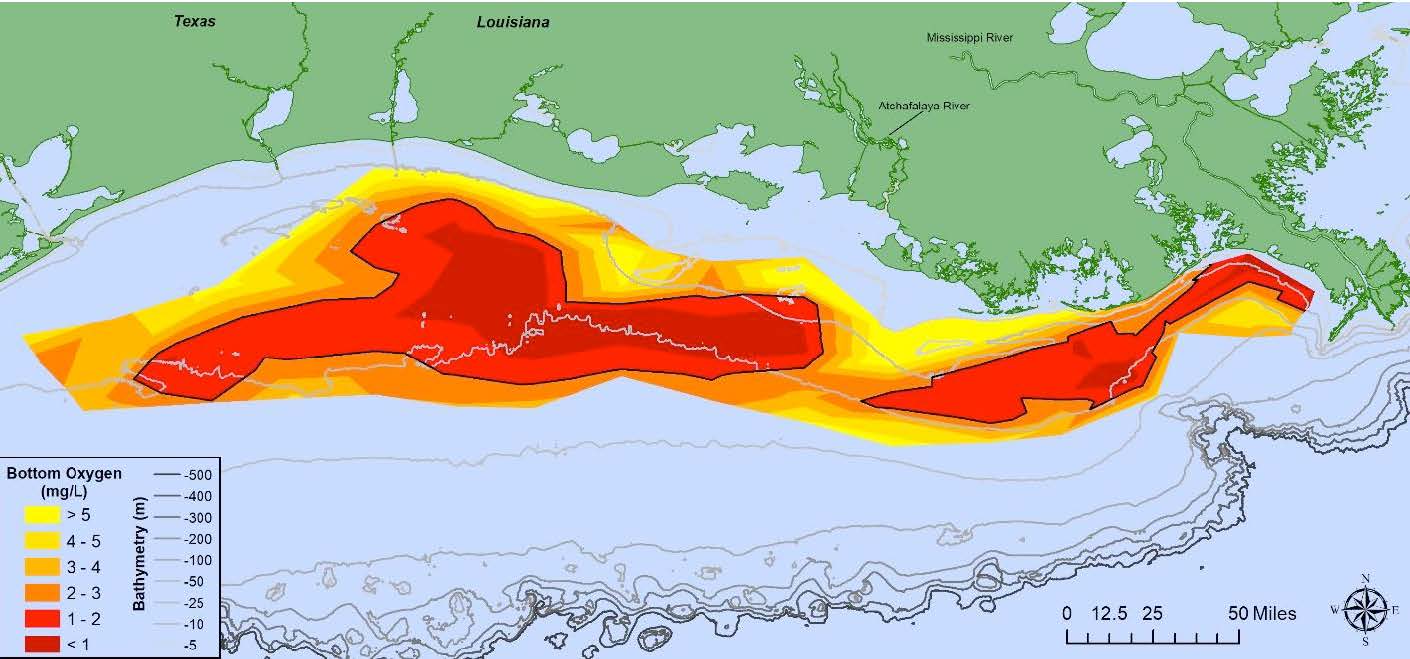NGI's Research Partner, Louisiana University's Marine Consortium (LUMCON), Releases Summer 2020 Hypoxia Report
June 3, 2020

Oxygen concentrations in bottom water across the Louisiana shelf from July 23 – July 30, 2019. Data source: N.N. Rabalais, Louisiana State University, Louisiana Universities Marine Consortium, and R.E. Turner, LSU; funded by NOAA, National Centers for Coastal Ocean Science.
A hypoxic water mass with oxygen concentrations ≤ 2 mg l-1 forms in bottom waters of the northern Gulf of Mexico continental shelf each year. Nutrients from the Mississippi River watershed, particularly nitrogen and phosphorus, fertilize the Gulf’s surface waters to create excessive amounts of algal biomass, whose decomposition in the bottom layer leads to oxygen depletion.
The low oxygen conditions in the Gulf's most productive waters stresses organisms and may even cause their death to threaten living resources, including humans depending on the fish, shrimp and crabs caught there. Various models use the May nitrogen load of the Mississippi River as the main driving force to predict the size of this hypoxic zone in late July.
Our prediction is based on one of these models.
The June 2020 forecast of the size of the hypoxic zone in the northern Gulf of Mexico for late July 2020 is that it will cover 20,121 km2 (7,769 mi2) of the bottom of the continental shelf off Louisiana and Texas. The 95% confidence interval is that it will be between 18,054 and 22,089 km2 (6,971 and 8,529 mi2). This estimate is based on the assumption that there are no significant tropical storms in the two weeks before the monitoring cruise, or during the cruise. If a storm does occur, then the size of the zone is predicted to be 70% of the predicted size without the storm, equivalent to 14,085 km2 (5,438 mi2).
The predicted hypoxic area is slightly less than the size of the land area of New Hampshire (23,227 km2) and 146% of the average of 13,829 km2 (n = 34 including years with storms). If the area of hypoxia becomes as large as predicted, then it will be 4 times the size of the Hypoxia Action Plan goal to reduce the zone to less than 5,000 km2.
No reductions in the nitrate loading from the Mississippi River to the Gulf of Mexico have occurred in the last few decades.
Caveats:
-
This prediction discounts the effect of large storm events that temporarily disrupt the physical and biological system attributes promoting the formation of the low oxygen zone in bottom waters;
-
The potential space on the shelf where hypoxia occurs is limited by the bathymetry;
-
The prediction assumes that there will be no abrupt changes in discharge from now through July; and
-
Unusual weather patterns affecting coastal winds, as experienced in 2009, 2011, 2018, and 2019 may reduce the hypoxic zone size to be lower than predicted.
